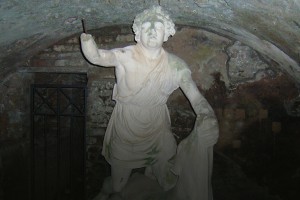
Most young Christians discover claims such as these while surfing the Internet or sitting in classes as university students. Atheists like Richard Carrier and David Fitzgerald have written extensively about such comparisons. But while there are a number of pre-Christian mythologies with dying saviors, none are similar to Jesus in any significant way, including the Mithraic mystery religions of Persia and Rome. A significant portion of what we just described about Mithras is simply false. There are two distinct and non-continuous traditions related to Mithras, one coming out of the areas of India and Iran, and another, centuries later in Roman times. Many skeptics have struggled to try to connect these as one continuous tradition, and in so doing, have distorted or misinterpreted the basic elements of the tradition and mythology. Much of what is presumed about Mithras comes from ancient, caption-less pictures and murals, so the vast majority of scholarly work on Mithras is pure speculation. Let’s take a look at the claims we have already described and separate truth from fiction (for another examination of Mithras and many other alleged Christian precursors, please visit David Anderson’s excellent website. I’ve also done much research on Mithras from the texts listed at the end of this blog post):
Claim: Mithras was born of a virgin on December 25th, in a cave, attended by shepherds
Truth: Mithras was actually born out of solid rock, leaving a hole in the side of a mountain (presumably described as a “cave”). He was not born of a virgin (unless you consider the rock mountain to have been a virgin). His birth was celebrated on December 25th, but the first Christians knew this was not the true date of Christ’s birth anyway, and both Mithraic worshippers and the early Roman Church borrowed this celebration from earlier winter solstice celebrations. Shepherds are part of Mithraism, witnessing his birth and helping Mithras emerge from the rock, but interestingly, the shepherds exist in the birth chronology at a time when humans are not supposed to have been yet born. This, coupled with the fact the earliest version of this part of the Mithraic mythology emerges one hundred years after the appearance of the New Testament, infers it is far more likely this portion of Mithraism was borrowed from Christianity rather than the other way around.
Claim: Mithras was considered a great traveling teacher and master
Truth: There is nothing in the Mithraic tradition indicating he was a teacher of any kind, but he was could have been considered a master of sorts. This would not be unexpected of any deity, however. Most mythologies describe their gods in this way.
Claim: Mithras had 12 companions or disciples
Truth: There is no evidence for any of this in the traditions of Iran or Rome. It is possible the idea Mithras had 12 disciples is simply derived from murals in which Mithras is surrounded by twelve signs and personages of the Zodiac (two of whom are the moon and the sun). Even this imagery is post Christian, and, therefore, did not contribute to the imagery of Christianity (although it could certainly have borrowed from Christianity).
Claim: Mithras promised his followers immortality
Truth: While there is little evidence for this, it is certainly reasonable to think Mithras might have offered immortality, as this is not uncommon for any God of mythology.
Claim: Mithras performed miracles
Truth: Of course this is true, as this too was not uncommon for mythological characters.
Claim: Mithras sacrificed himself for world peace
Truth: There is little or no evidence this is true, although there is a story about Mithras slaying a threatening bull in a heroic deed. But that’s about as close as it gets.
Claim: Mithras was buried in a tomb and after three days rose again, and Mithras was celebrated each year at the time of His resurrection (later to become Easter)
Truth: There is nothing in the Mithraic tradition indicating he ever even died, let alone resurrected. Tertullian did write about Mithraic believers re-enacting resurrection scenes, but he wrote about this occurring well after New Testament times. Christianity could not, therefore, have borrowed from Mithraic traditions, but the opposite could certainly be true.
Claim: Mithras was called “the Good Shepherd”, and was identified with both the Lamb and the Lion
Truth: There is no evidence that Mithras was ever called “the Good Shepherd” or identified with a lamb, but since Mithras was a sun-god, there was an association with Leo (the House of the Sun in Babylonian astrology), so one might say he was associated with a Lion. But once again, all of this evidence is actually post New Testament; Mithraic believers may once again have borrowed this attribute from Christianity.
Claim: Mithras was considered to be the “Way, the Truth and the Light,” and the “Logos,” “Redeemer,” “Savior” and “Messiah.”
Truth: Based on the researched and known historic record of the Mithraic traditions, none of these terms has ever been applied to Mithras with the exception of “mediator”. But this term was used in a very different from how Christians used the term. Mithras was not the mediator between God and man but the mediator between the good and evil gods of Zoroaster.
Claim: Mithraic believers celebrated Sunday as Mithras’ sacred day (also known as the “Lord’s Day,”)
Truth: This tradition of celebrating Sunday is only true of Mithraic believers in Rome and it is a tradition that dates to post Christian times. Once again, it is more likely to have been borrowed from Christianity than the other way around.
Claim: Mithraic believers celebrated a Eucharist or “Lord’s Supper”
Truth: Followers of Mithras did not celebrate a Eucharist, but they did celebrate a fellowship meal regularly, just as did many other groups in the Roman world.
Mithras isn’t much like Jesus after all. It’s not unusual for the characteristics of ancient pre-Christian deities to be exaggerated in an effort to make them sound like Jesus. Share on X
From this quick examination of the Mithraic comparisons, it should be obvious Mithras isn’t much like Jesus after all. It’s not unusual for the characteristics of ancient pre-Christian deities to be exaggerated in an effort to make them sound like Jesus. The first step in refuting such claims is to simply investigate the attributes carefully. Beyond this, we must also recognize the expectations and yearnings people have related to the existence of God. The Bible rightly describes this yearning and the innate knowledge each of us has related to God’s existence (Romans 1:18-20 and 2:12-16). We shouldn’t be surprised ancient people (created in the image of God) would think deeply about the nature of this God. Many alleged similarities between pre-Christian mythologies and Jesus are extremely general in nature and would be expected from anyone considering the existence of a Divine Creator. Primitive cultures interested in God’s nature reasoned He would have the ability to perform miracles, teach humans and form disciples. These universal expectations fail to invalidate the historicity of Jesus. As Paul recognized on Mars Hill (Acts 17:22-31), men thought deeply about the nature of God prior to His arrival as Jesus. Sometimes they imagined the details correctly, sometimes they didn’t. In the end, similarities between Jesus and mythological precursors fail to invalidate the historicity of Jesus. The historical veracity of Jesus is determined from the evidence supporting the reliability of the eyewitness accounts. Share on X
In the end, similarities between Jesus and mythological precursors fail to invalidate the historicity of Jesus. The historical veracity of Jesus is determined from the evidence supporting the reliability of the eyewitness accounts. Jesus is not simply a retelling of Mithraic mythology. While Mithras is no longer worshiped, Christianity continues to thrive. Why? Because the Christian records are reliable. Skeptics sometimes portray Mithras as something he isn’t in order to keep us from believing in Jesus as something He is. But the reliable Biblical record establishes the Deity of Jesus in a way no other ancient mythological text could ever hope to achieve.

J. Warner Wallace is a Dateline featured Cold-Case Detective, Senior Fellow at the Colson Center for Christian Worldview, Adj. Professor of Christian Apologetics at Talbot School of Theology, Biola University, author of Cold-Case Christianity, God’s Crime Scene, and Forensic Faith, and creator of the Case Makers Academy for kids.
Subscribe to J. Warner’s Daily Email
Note: For more information about Mithraism, refer to three important volumes related to the Mithraic Cult. These later works are far more reliable than 19th century scholarship (often cited by skeptics who claim Jesus is a retelling of Mithras): The Origins of the Mithraic Mysteries (Cosmology and Salvation in the Ancient World) by David Ulansey (Oxford University Press, 1989), Mithras, the Secret God by M. J. Vermaseren (Barnes and Noble Publishers, 1963), and Mithraic Studies (Proceedings of the First International Congress of Mithraic Studies – 2 Volumes) edited by John R Hinnells (Manchester University Press, 1975).
Save
J. Warner Wallace is a Dateline featured cold-case homicide detective, popular national speaker and best-selling author. He continues to consult on cold-case investigations while serving as a Senior Fellow at the Colson Center for Christian Worldview. He is also an Adj. Professor of Christian Apologetics at Talbot School of Theology, Biola University, and a faculty member at Summit Ministries. He holds a BA in Design (from CSULB), an MA in Architecture (from UCLA), and an MA in Theological Studies (from Gateway Seminary).

































Pingback: Is Jesus Simply a Retelling of the Mithras Myth...
Pingback: Is Jesus Simply a Retelling of the Osiris Mythology? - Cross Examined - Christian Apologetic Ministry | Frank Turek | Christian Apologetics | Christian Apologetics Speakers
Pingback: Is Jesus Simply a Retelling of the Osiris Mythology? | Apologetics ForumApologetics Forum
Pingback: The Uniqueness of Jesus | Truth Revolution Radio Show
Pingback: Is Jesus Simply a Retelling of the Osiris Mythology? | Cold Case Christianity
Pingback: Is Jesus Simply a Retelling of the Osiris Mythology? | New York Apologetics
Pingback: Jesus: one of many myths? – AntWoord
Pingback: Was Jesus Based on Myths Like Horus and Mithras? – Cyber Penance
Pingback: The Mithras Hoax – Kari Rimbey
Pingback: JESUS' BIRTH vs. ANCIENT MYTHS - EQUIP 4:12
Pingback: Is Jesus Simply a Retelling of the Mithras Mythology? | Cold Case Christianity – Elders Scrolls
Pingback: Homepage